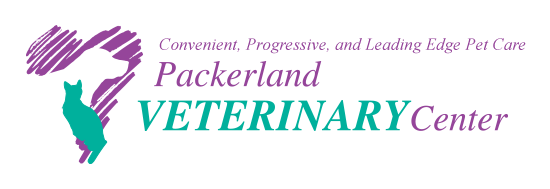

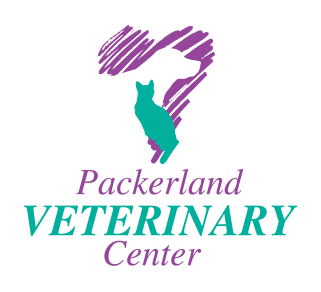
SERVICES
Canine Hip Injuries

Hip dysplasia is a relatively common disorder of the hip joints in dogs. It is a condition that is progressive in nature and, if left untreated or undetected, can cause irreversible damage to the joints. Dog's hips are very similar in anatomy to ours in the sense that it is a ball and socket configuration. A diagnosis of hip dysplasia means that the fit of the ball within the socket is less than ideal. This poor fit allows instability or "slop" within the joint. The laxity present allows for excessive movement within the joint which creates inflammation, causes abnormal wear on the cartilage surface and creates arthritis.
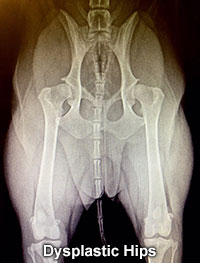
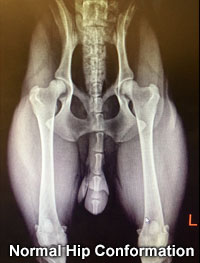
Diagnosis of hip dysplasia is fairly straightforward. A thorough physical examination is followed by radiographs, which help us visualize the fit of the joint and any associated arthritic changes. Hip Dysplasia is a condition linked to genetics as well as environmental factors such over-feeding and excessive exercise. Even though it may be present at birth, it is unlikely you will see signs of the disorder at a very young age. Early detection of the disorder, however, allows for greater success in treatment, and the chance to prevent significant damage to the joint.
Treatment for hip dysplasia falls under the general categories of medical and surgical options. Medical treatment of hip dysplasia is in an attempt to keep the patient comfortable. Medical therapy will not improve the joint looseness which is the cause of all the problems that develop, but rather will help decrease inflammation to hopefully allow the individual animal to cope with the existing instability. Weight loss, exercise moderation, anti-inflammatory medications, and cartilage and joint fluid building block products are all considerations for the medical patient. Stem Cell Therapy would also fall under a medical treatment of hip dysplasia. The injection of stem cells into a dysplastic joint does not address the conformation or laxity present, but will work to reduce inflammation and rebuild joint cartilage to make the pet more comfortable.
Surgical treatment for hip dysplasia is the only definitive method of influencing joint laxity and permanently removing the arthritic changes that develop subsequent to the inflammatory changes that occur. In young animals, it may be possible to preserve their existing anatomy by changing the angulation of the hip joint to improve the fit of the ball and socket. However, once significant changes begin to develop in the joint, we are limited in the options that are available and often need to remove the arthritis that is present by one of two surgical procedures.
Treatment options include:
Triple Pelvic Osteotomy (TPO)
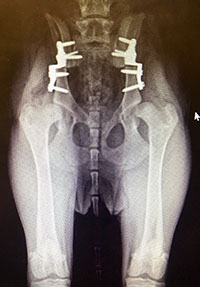 TPO involves cutting the pelvic bone and repositioning it which results in an improved fit of the joint. It is a technically demanding surgery and its success depends upon improved remodeling of the hip joint as the dog continues to grow. In order for this procedure to be successful it must be completed prior to the fusion of the growth plates which means we must identify hip dysplasia early enough to perform surgery between 5 and 8 months of age. TPO gives us the opportunity to preserve the anatomy that is already present, making it an ideal option if caught early enough.
TPO involves cutting the pelvic bone and repositioning it which results in an improved fit of the joint. It is a technically demanding surgery and its success depends upon improved remodeling of the hip joint as the dog continues to grow. In order for this procedure to be successful it must be completed prior to the fusion of the growth plates which means we must identify hip dysplasia early enough to perform surgery between 5 and 8 months of age. TPO gives us the opportunity to preserve the anatomy that is already present, making it an ideal option if caught early enough.
Femoral Head Ostectomy (FHO)
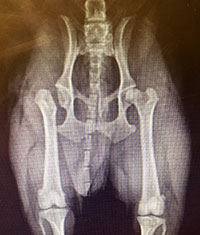 FHO can be performed on pets of any age and with any severity of hip dysplasia. The procedure involves removing the femoral head (ball), thus creating a ‘false' joint made up of soft scar-like tissue separating the pelvis and femur bone with no remaining bony attachment. This procedure is a salvage procedure as it preserves limb function at the compromise of some physical abilities. The FHO provides better results in small and medium sized pets versus the larger or giant breeds and/or athletic pets. It is, however, an economical way to preserve use of the limb and decrease the pain associated with hip dysplasia.
FHO can be performed on pets of any age and with any severity of hip dysplasia. The procedure involves removing the femoral head (ball), thus creating a ‘false' joint made up of soft scar-like tissue separating the pelvis and femur bone with no remaining bony attachment. This procedure is a salvage procedure as it preserves limb function at the compromise of some physical abilities. The FHO provides better results in small and medium sized pets versus the larger or giant breeds and/or athletic pets. It is, however, an economical way to preserve use of the limb and decrease the pain associated with hip dysplasia.
Total Hip Replacement (THR)
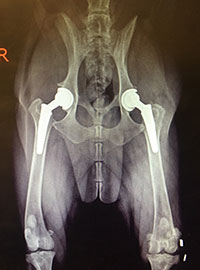 This procedure can only be performed on patients who are skeletally mature. The THR provides the best results and preserves the most athletic ability of all the hip dysplasia surgical options. THR involves removing both the ball and socket portions of the joint and replacing them with new, prosthetic implants and is very similar to human hip replacement procedures. The implants are placed in one of two ways, either using bone cement or a biologic/ingrowth (cementless) system where implants are coated with a porous titanium that allows the bone to grow into the implant. The cementless system is highly recommended in younger patients as it has less potential for long-term complications. The cemented system does still provide excellent results for patients who, because of bone conformation, may not be candidates for a cementless system or those looking for a more economical THR.
This procedure can only be performed on patients who are skeletally mature. The THR provides the best results and preserves the most athletic ability of all the hip dysplasia surgical options. THR involves removing both the ball and socket portions of the joint and replacing them with new, prosthetic implants and is very similar to human hip replacement procedures. The implants are placed in one of two ways, either using bone cement or a biologic/ingrowth (cementless) system where implants are coated with a porous titanium that allows the bone to grow into the implant. The cementless system is highly recommended in younger patients as it has less potential for long-term complications. The cemented system does still provide excellent results for patients who, because of bone conformation, may not be candidates for a cementless system or those looking for a more economical THR.
Fracture Repair
At Packerland Veterinary Center, we are able to handle the simplest of broken bones, all the way through the most complex of fracture presentations. Dr. Dunbar's extensive training and orthopedic experience have given him the tools to provide the best care possible for fractures of all shapes and sizes.
There is no cookie cutter method to approach every patient with a broken bone. We have to be flexible in the methods that we have available to approach each individual situation. Some fractures may heal adequately with external support such as casting, while others require elaborate bone plate and screw repairs along with bone grafting techniques. The trick is to know what works with each fracture presentation, and to be able to perform the procedure in a manner that will give the patient the best recovery possible.
Stem Cell Therapy (SCT)
This procedure involves surgically harvesting fat tissue from your pet and then processing that tissue in house to remove the stem cells. The stem cells are then "activated" with our special equipment and later the same day we can inject the cells back into specific areas of the patient where needed. In the case of hip dysplasia, SCT does not change the laxity that is present, but those stem cells will help to reduce inflammation from the joint and rebuild the joint cartilage surface, making the pet more comfortable overall. Stem Cell Therapy has drastically improved the quality of life in many of our arthritic patients!
For more in-depth information about Stem Cell Therapy, click here.
Hip Evaluation – PENN HIP AND OFA Certified
It may be important to evaluate the hip conformation of a dog, particularly if it is intended to be involved in a breeding program. With our extensive hip evaluation work, we can give a "highly educated" opinion, but when official documentation is needed we are certified to take both PENN HIP and OFA evaluation radiographs. Typically the positioning for these highly specific radiographs does require sedation, making this a day procedure. OFA radiographs certify dogs after 2 years of age, while PENN HIP's distraction index can evaluate any dog after 16 weeks of age.



